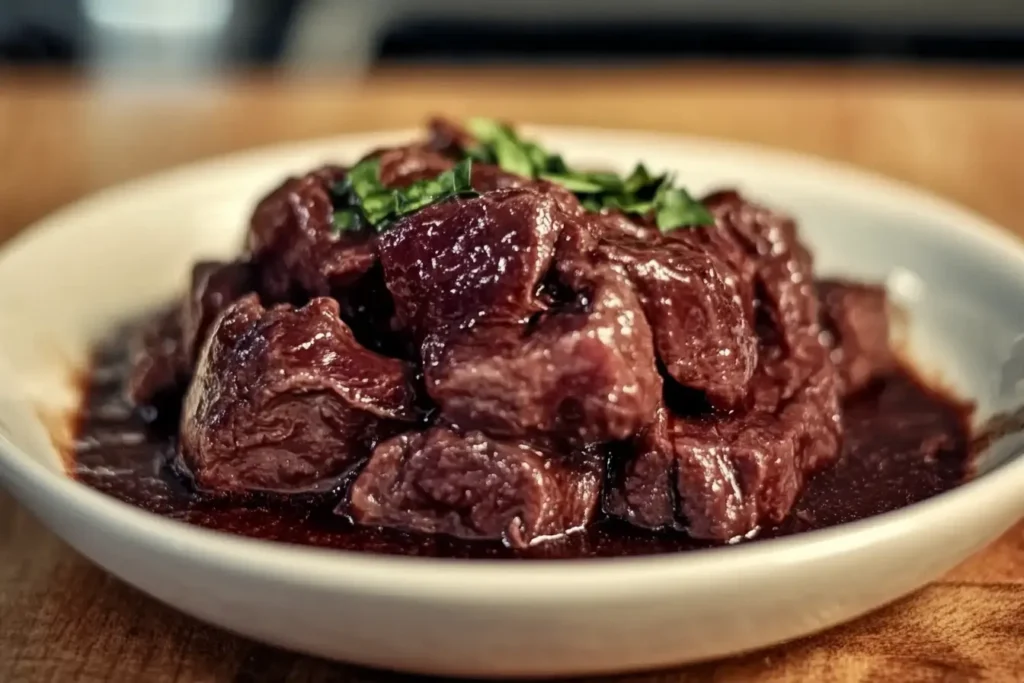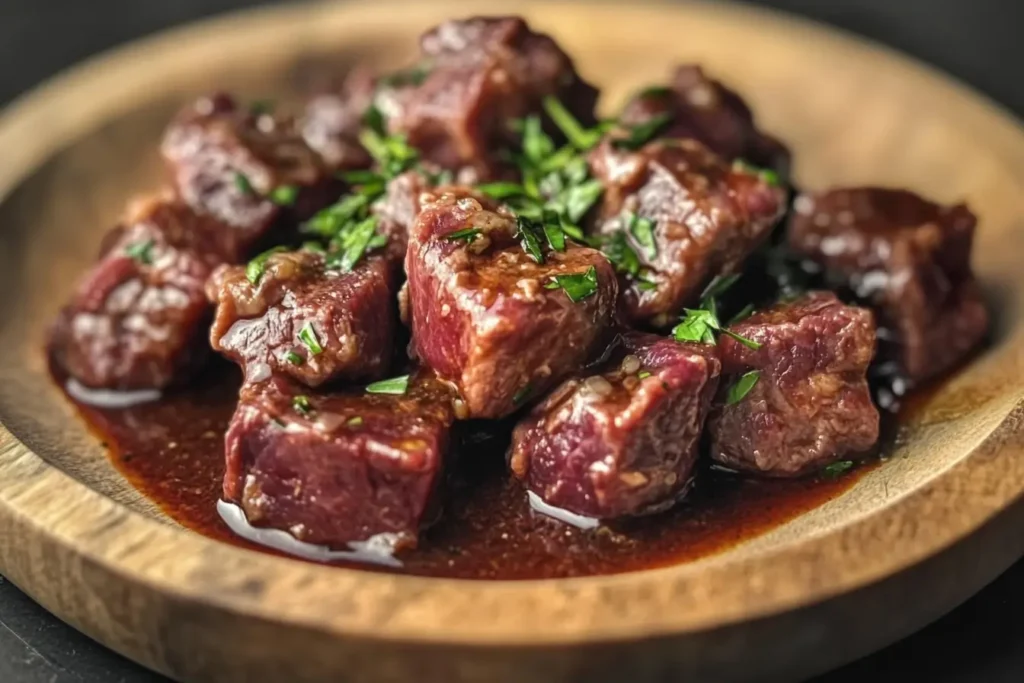Beef cheek meat is one of the most underrated cuts of beef, yet it offers rich, bold flavors and an unbeatable texture when cooked properly. If you’ve never tried cooking beef cheeks, you’re in for a treat. Whether you’re making tacos, a hearty ragu, or a luxurious braised dish, beef cheeks bring something truly special to the table.
In this guide, we’ll dive into everything you need to know about beef cheek meat: its benefits, best cooking methods, common issues, and some mouthwatering recipes to inspire your next meal.

Table of Contents
What Is Beef Cheek Meat?
Understanding the Cut: What Are Beef Cheeks?
Beef cheek meat, also known as “cachete” in Spanish, is the muscle located in the cheek of a cow. Because this muscle works hard throughout the animal’s life, the meat is naturally tough but packed with connective tissue and collagen. When slow-cooked, these elements break down, creating an incredibly tender and flavorful dish.
Think of beef cheeks as the culinary equivalent of a diamond in the rough—unassuming at first, but pure gold when treated right.
Why Is Beef Cheek Meat So Popular in Cooking?
Chefs and home cooks alike love beef cheek meat for its:
- Unmatched Flavor: The robust, beefy taste is perfect for dishes that require depth and richness.
- Incredible Tenderness: When cooked low and slow, beef cheeks become melt-in-your-mouth tender.
- Versatility: From tacos to gourmet French cuisine, beef cheeks work in a variety of dishes and cuisines.
Nutritional Benefits of Beef Cheek Meat
High in Protein, Low in Fat
Beef cheek meat is an excellent source of protein, making it ideal for those looking to build or maintain muscle. Despite its rich flavor, it’s surprisingly lean compared to other cuts of beef.
Rich in Collagen for Joint and Skin Health
Because of its high collagen content, beef cheek meat is a fantastic choice for improving skin elasticity and promoting joint health. Regularly consuming collagen-rich foods can help keep you feeling and looking your best.
Packed with Vitamins and Minerals
Beef cheeks are loaded with essential nutrients like iron, zinc, and B vitamins, which support energy production, immune function, and overall well-being.
Common Uses for Beef Cheek Meat
Traditional Dishes Featuring Beef Cheeks
Beef cheeks have been a staple in many traditional cuisines:
- French: Red wine-braised beef cheeks are a classic dish in French gastronomy.
- Mexican: Tacos de cachete, or beef cheek tacos, are a beloved street food in Mexico.
- Italian: Beef cheek ragu served over pasta is a hearty, comforting meal perfect for special occasions.
Modern Culinary Trends Using Beef Cheek Meat
In recent years, beef cheeks have gained popularity among modern chefs for their ability to elevate casual and fine dining dishes. They’re now commonly featured in gourmet tacos, sliders, and even Asian-inspired soups.
Why It’s Perfect for Slow-Cooking and Braising
The tough fibers and connective tissue in beef cheeks make them ideal for slow-cooking methods like braising, where they absorb the flavors of the cooking liquid and transform into a silky, tender texture.
How to Select and Prepare Beef Cheek Meat
Choosing Quality Beef Cheeks: What to Look For
When buying beef cheek meat, look for cuts that are:
- Bright Red in Color: This indicates freshness.
- Well-Marbled: A bit of fat ensures the meat remains tender and flavorful during cooking.
- Clean and Trimmed: Avoid cuts with excessive sinew or gristle, as these can be difficult to cook.
Cleaning and Trimming Beef Cheek Meat Properly
While most butchers sell pre-trimmed beef cheeks, you may need to do some additional prep at home. Remove any silver skin or excess fat to ensure even cooking and a better texture.
Prepping Tips for the Perfect Dish
- Marinate the Meat: Let the beef cheeks sit in a flavorful marinade for several hours to enhance the taste.
- Sear Before Cooking: Browning the meat in a hot pan locks in flavor and creates a caramelized crust that adds depth to your dish.
Block Quote:
“Beef cheek meat is like the hidden gem of the butcher’s counter—once you try it, you’ll wonder why it isn’t more popular. 🥩✨”
Best Cooking Methods for Beef Cheek Meat
Braising: The Classic Method for Tender Beef Cheeks
Braising is the most popular way to cook beef cheeks—and for good reason. This technique involves slow-cooking the meat in a flavorful liquid, allowing the connective tissue to break down into a melt-in-your-mouth texture.
How to Braise Beef Cheeks:
- Sear the Meat: Heat oil in a heavy pot, then sear the beef cheeks on all sides until golden brown.
- Prepare the Liquid: Add aromatics like onions, garlic, and carrots, then pour in broth, wine, or tomato-based liquids.
- Simmer Low and Slow: Cover and cook on low heat for 3-4 hours, either on the stovetop or in the oven at 325°F.
Pro Tip: Don’t rush the process! The magic happens when the collagen has time to transform into gelatin, giving the meat its signature tenderness.
Slow-Cooking Beef Cheek Meat for Maximum Flavor
A slow cooker is your best friend for a hands-off approach to tender beef cheeks.
- How to Use It: Place seared beef cheeks, vegetables, and liquid into the slow cooker. Set it on low for 6-8 hours, and let the magic happen.
- Best Liquids: Beef broth, red wine, or even coconut milk for an exotic twist.
Sous Vide Cooking for Precision and Consistency
If you’re looking for a foolproof way to cook beef cheeks, sous vide is the answer. This method involves vacuum-sealing the meat and cooking it in a water bath at a precise temperature for several hours.
- Temperature and Time: Cook beef cheeks at 185°F (85°C) for 8-10 hours.
- Finish with a Sear: After sous vide, quickly sear the meat for a golden crust.
Popular Recipes Using Beef Cheek Meat

Tacos de Cachete (Beef Cheek Tacos)
A staple in Mexican street food, these tacos are bursting with flavor.
Ingredients:
- 2 lbs beef cheeks
- 1 onion, halved
- 2 garlic cloves
- 1 tsp cumin
- 1 tsp chili powder
- Corn tortillas
- Toppings: diced onions, fresh cilantro, lime wedges
Instructions:
- Slow-cook the beef cheeks with onion, garlic, cumin, and chili powder in a slow cooker for 6-8 hours.
- Shred the meat and serve on warm corn tortillas.
- Add your favorite toppings and a squeeze of lime juice.
Beef Cheek Ragu Over Pasta
Transform beef cheeks into a decadent ragu for pasta lovers.
Ingredients:
- 4 beef cheeks
- 1 onion, diced
- 2 garlic cloves, minced
- 1 cup red wine
- 1 can crushed tomatoes
- 2 cups beef broth
- 1 tsp Italian seasoning
- Pasta of choice
Instructions:
- Sear the beef cheeks and set aside.
- Sauté onions and garlic, then deglaze with red wine.
- Add crushed tomatoes, beef broth, and seasoning. Return the beef cheeks and simmer for 3-4 hours.
- Shred the meat and toss with cooked pasta.
For another bold recipe idea, try this Progresso Chicken Pot Pie Soup for a hearty, comforting meal.
Common Problems and Solutions When Cooking Beef Cheek Meat
How to Fix Beef Cheeks That Are Too Tough
Tough beef cheeks are usually the result of undercooking.
- Solution: Return the meat to the pot and continue cooking until the connective tissue breaks down. Add more liquid if needed.
Preventing Bland Flavors in Your Dishes
If your beef cheeks lack flavor, the problem might be in the seasoning or cooking liquid.
- Solution: Season generously with salt and spices before cooking. Use flavorful liquids like broth, wine, or tomato-based sauces to infuse the meat.
Avoiding Overcooked or Dry Beef Cheeks
While it’s hard to overcook beef cheeks when slow-cooking, it’s not impossible.
- Solution: Keep an eye on the liquid level during cooking to prevent drying out. Adding a lid or foil helps retain moisture.
Block Quote:
“Cooking beef cheeks is all about patience. The longer you let them simmer, the more they reward you with tender, flavorful bites. 🥩✨”
Storing and Reheating Beef Cheek Meat
Tips for Refrigerating and Freezing Cooked Beef Cheeks
Proper storage ensures that you can enjoy beef cheeks long after cooking without sacrificing flavor or texture:
- Refrigeration: Place leftover beef cheeks in an airtight container and store them in the refrigerator for up to 3-4 days. Keep the cooking liquid or sauce to prevent the meat from drying out.
- Freezing: To freeze, separate the meat and sauce into portions. Use freezer-safe bags or containers to store them for up to 3 months.
Pro Tip: Label your containers with the date so you know when they’re ready to eat or discard.
How to Reheat Without Losing Tenderness
Reheating beef cheeks properly is key to maintaining their melt-in-your-mouth texture:
- On the Stovetop: Heat gently in the original sauce over low to medium heat, stirring occasionally until warmed through.
- In the Oven: Preheat to 300°F, place the meat in a covered dish with some sauce or broth, and reheat for 20-30 minutes.
- In the Microwave: Use short intervals and cover the dish with a damp paper towel to retain moisture.
Avoid reheating the meat multiple times to preserve its flavor and texture.
Best Practices for Storing Leftover Sauces and Gravies
The cooking liquid or sauce is a goldmine of flavor. Here’s how to store it:
- Freeze extra sauce in ice cube trays for easy portioning.
- Refrigerate in a sealed container for up to 4-5 days. Use it as a base for soups, stews, or even pasta sauces.
Where to Buy Quality Beef Cheek Meat

Local Butcher Shops and Markets
For the freshest beef cheek meat, visit your local butcher. They can guide you on selecting the best cuts and may even offer trimming services. Farmers’ markets are another excellent source for high-quality, locally sourced meat.
Online Sources for High-Quality Beef Cheeks
If you can’t find beef cheeks locally, online retailers are a great option. Websites like Crowd Cow, Porter Road, and Snake River Farms offer premium cuts of beef, including beef cheeks. These services often provide organic or grass-fed options as well.
Sustainable and Organic Beef Options
For environmentally conscious cooking, look for beef cheeks labeled as organic, grass-fed, or sustainably sourced. These options not only taste better but also align with ethical and eco-friendly practices.
Conclusion: Why Beef Cheek Meat Deserves a Spot in Your Kitchen
Beef cheek meat might not be the most glamorous cut of beef, but it’s undoubtedly one of the most rewarding. Its bold flavor, tender texture, and versatility make it a standout ingredient for everything from casual tacos to elegant braised dishes.
With the right preparation, beef cheeks transform into something truly extraordinary. Whether you’re slow-cooking them for hours or experimenting with sous vide, this cut delivers every time. Plus, with its nutritional benefits and affordable price point, beef cheek meat is a win for both your palate and your wallet.
So why not give it a try? Your taste buds—and everyone at your dinner table—will thank you. 🥩✨
Block Quote:
“Beef cheek meat is proof that some of the best things in life take time. With patience and care, this humble cut becomes a culinary masterpiece. 🍷💖”
